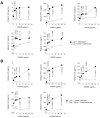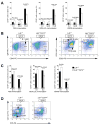Deficiency of antigen-presenting cell invariant chain reduces atherosclerosis in mice
- PMID: 20697023
- PMCID: PMC2927799
- DOI: 10.1161/CIRCULATIONAHA.109.891887
Deficiency of antigen-presenting cell invariant chain reduces atherosclerosis in mice
Abstract
Background: Adaptive immunity and innate immunity play important roles in atherogenesis. Invariant chain (CD74) mediates antigen-presenting cell antigen presentation and T-cell activation. This study tested the hypothesis that CD74-deficient mice have reduced numbers of active T cells and resist atherogenesis.
Methods and results: In low-density lipoprotein receptor-deficient (Ldlr(-/-)) mice, CD74 deficiency (Ldlr(-/-)Cd74(-/-)) significantly reduced atherosclerosis and CD25(+)-activated T cells in the atheromata. Although Ldlr(-/-)Cd74(-/-) mice had decreased levels of plasma immunoglobulin (Ig) G1, IgG2b, and IgG2c against malondialdehyde-modified LDL (MDA-LDL), presumably as a result of impaired antigen-presenting cell function, Ldlr(-/-)Cd74(-/-) mice showed higher levels of anti-MDA-LDL IgM and IgG3. After immunization with MDA-LDL, Ldlr(-/-)Cd74(-/-) mice had lower levels of all anti-MDA-LDL Ig isotypes compared with Ldlr(-/-) mice. As anticipated, only Ldlr(-/-) splenocytes responded to in vitro stimulation with MDA-LDL, producing Th1/Th2 cytokines. Heat shock protein-65 immunization enhanced atherogenesis in Ldlr(-/-) mice, but Ldlr(-/-) Cd74(-/-) mice remained protected. Compared with Ldlr(-/-) mice, Ldlr(-/-)Cd74(-/-) mice had higher anti-MDA-LDL autoantibody titers, fewer lesion CD25(+)-activated T cells, impaired release of Th1/Th2 cytokines from antigen-presenting cells after heat shock protein-65 stimulation, and reduced levels of all plasma anti-heat shock protein-65 Ig isotypes. Cytofluorimetry of splenocytes and peritoneal cavity cells of MDA-LDL- or heat shock protein-65-immunized mice showed increased percentages of autoantibody-producing marginal zone B and B-1 cells in Ldlr(-/-)Cd74(-/-) mice compared with Ldlr(-/-) mice.
Conclusions: Invariant chain deficiency in Ldlr(-/-) mice reduced atherosclerosis. This finding was associated with an impaired adaptive immune response to disease-specific antigens. Concomitantly, an unexpected increase in the number of innate-like peripheral B-1 cell populations occurred, resulting in increased IgM/IgG3 titers to the oxidation-specific epitopes.
Conflict of interest statement
The authors have declared that no conflict of interest exists.
Figures








Similar articles
-
Immunization with malondialdehyde-modified low-density lipoprotein (LDL) reduces atherosclerosis in LDL receptor-deficient mice challenged with Porphyromonas gingivalis.Innate Immun. 2015 May;21(4):370-85. doi: 10.1177/1753425914542444. Epub 2014 Aug 17. Innate Immun. 2015. PMID: 25134521
-
Immunization of LDL receptor-deficient mice with homologous malondialdehyde-modified and native LDL reduces progression of atherosclerosis by mechanisms other than induction of high titers of antibodies to oxidative neoepitopes.Arterioscler Thromb Vasc Biol. 1998 Dec;18(12):1972-82. doi: 10.1161/01.atv.18.12.1972. Arterioscler Thromb Vasc Biol. 1998. PMID: 9848892
-
SYK regulates macrophage MHC-II expression via activation of autophagy in response to oxidized LDL.Autophagy. 2015;11(5):785-95. doi: 10.1080/15548627.2015.1037061. Autophagy. 2015. PMID: 25946330 Free PMC article.
-
Autoimmune mechanisms of atherosclerosis.Handb Exp Pharmacol. 2005;(170):723-43. doi: 10.1007/3-540-27661-0_27. Handb Exp Pharmacol. 2005. PMID: 16596821 Review.
-
Atherogenesis and the humoral immune response to modified lipoproteins.Atherosclerosis. 2008 Oct;200(2):239-46. doi: 10.1016/j.atherosclerosis.2008.03.025. Epub 2008 Apr 12. Atherosclerosis. 2008. PMID: 18513726 Free PMC article. Review.
Cited by
-
Arrest Functions of the MIF Ligand/Receptor Axes in Atherogenesis.Front Immunol. 2013 May 16;4:115. doi: 10.3389/fimmu.2013.00115. eCollection 2013. Front Immunol. 2013. PMID: 23720662 Free PMC article.
-
microRNAs in the regulation of dendritic cell functions in inflammation and atherosclerosis.J Mol Med (Berl). 2012 Aug;90(8):877-85. doi: 10.1007/s00109-012-0864-5. Epub 2012 Feb 4. J Mol Med (Berl). 2012. PMID: 22307520 Review.
-
CD74 in Apoptotic Macrophages Is Associated with Inflammation, Plaque Progression and Clinical Manifestations in Human Atherosclerotic Lesions.Metabolites. 2022 Jan 10;12(1):54. doi: 10.3390/metabo12010054. Metabolites. 2022. PMID: 35050177 Free PMC article.
-
CD74 in Kidney Disease.Front Immunol. 2015 Sep 23;6:483. doi: 10.3389/fimmu.2015.00483. eCollection 2015. Front Immunol. 2015. PMID: 26441987 Free PMC article. Review.
-
Topographical and biological evidence revealed FTY720-mediated anergy-polarization of mouse bone marrow-derived dendritic cells in vitro.PLoS One. 2012;7(5):e34830. doi: 10.1371/journal.pone.0034830. Epub 2012 May 31. PLoS One. 2012. PMID: 22693544 Free PMC article.
References
-
- Rose N, Afanasyeva M. Autoimmunity: busting the atherosclerotic plaque. Nat Med. 2003;9:641–642. - PubMed
-
- Abou-Raya A, Abou-Raya S. Inflammation: a pivotal link between autoimmune diseases and atherosclerosis. Autoimmun Rev. 2006;5:331–337. - PubMed
-
- Libby P. Role of inflammation in atherosclerosis associated with rheumatoid arthritis. Am J Med. 2008;121:S21–S31. - PubMed
-
- Hansson GK, Libby P. The immune response in atherosclerosis: a double-edged sword. Nat Rev Immunol. 2006;6:508–519. - PubMed
-
- Mallat Z, Gojova A, Brun V, Esposito B, Fournier N, Cottrez F, Tedgui A, Groux H. Induction of a regulatory T cell type 1 response reduces the development of atherosclerosis in apolipoprotein E-knockout mice. Circulation. 2003;108:1232–1237. - PubMed
Publication types
MeSH terms
Substances
Grants and funding
- P01 HL088093/HL/NHLBI NIH HHS/United States
- R01 HL088547/HL/NHLBI NIH HHS/United States
- HL60942/HL/NHLBI NIH HHS/United States
- HL56985/HL/NHLBI NIH HHS/United States
- HL086559/HL/NHLBI NIH HHS/United States
- HL88547/HL/NHLBI NIH HHS/United States
- P50 HL056985/HL/NHLBI NIH HHS/United States
- R01 HL081090/HL/NHLBI NIH HHS/United States
- R01 HL060942/HL/NHLBI NIH HHS/United States
- R01 HL086559/HL/NHLBI NIH HHS/United States
- HL81090/HL/NHLBI NIH HHS/United States
- HL83154/HL/NHLBI NIH HHS/United States
- R01 HL083154/HL/NHLBI NIH HHS/United States
LinkOut - more resources
Full Text Sources
Medical
Molecular Biology Databases
Research Materials

